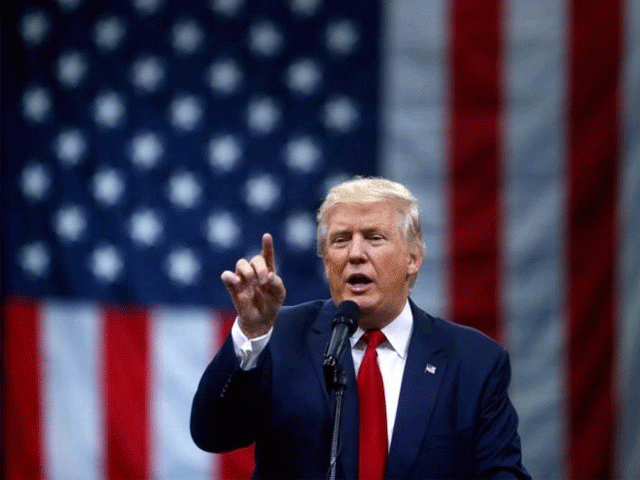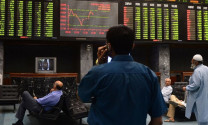US isolationist on trade, but more financially dependent on rest of world: experts
With Trump determined to press ahead with protectionist agenda, trading partners China and Europe likely to retaliate

PHOTO: REUTERS
Just as the United States is isolating itself on the global trade stage, its financial dependence on the rest of the world may be about to increase.
Figures on Wednesday showed that the US trade deficit in January was the widest in more than nine years at $56.6 billion.
A day earlier, Donald Trump's top economic adviser Gary Cohn resigned after he lost a fight over the president's plans for hefty steel and aluminum import tariffs.
Pakistan may suffer from domino effect if world goes to ‘trade war’
With Trump determined to press ahead with his protectionist agenda, major trading partners like China and Europe are likely to retaliate.
Global trade tensions are escalating rapidly. Not only is the trade deficit widening, Trump's tax cuts and spending plans will blow out the budget deficit too, requiring overseas investors to buy up larger amounts of the increased debt load Treasury will issue.
Foreigners' willingness to fund Uncle Sam's largesse has been a topic of hot debate for much of the last 20 years as the current account deficit, and to a lesser extent the budget deficit, have widened.
Experts urge ‘true’ implementation of trade policy
The ebb and flow of that demand has played an important role in determining the dollar's value on the world's foreign exchanges, especially in the mid-2000s when both deficits widened rapidly in tandem.
US deficits may have played a diminished role for the dollar in the years following the crisis to around 2014 as these deficits shrank. The dollar rose 30 per cent in the three years from 2014 to 2016, whittling away FX intervention-fueled demand for US bonds from foreign central banks.
But the deficits are widening again and the Fed is reducing its bond portfolio, meaning the market may need to absorb Treasury bond issuance worth around 5 per cent of GDP or higher.
The dollar is down 15 per cent in barely a year, and President Trump's desire to impose tariffs on a range of US imports has fueled talk of a global trade war. Will foreign investors, private and official sector, step up?
Watch FX reserves
Former Treasury Secretary Larry Summers this week warned that, based on current bond yield differentials, the dollar could lose a quarter of its value against its major peers over the next decade.
"The confidence of global markets is much easier to maintain than to regain. Currency markets are sending a signal that the US is not on a healthy path," Summers said.
Trump vows to keep steel tariffs on Mexico, Canada without 'fair' NAFTA deal
A perception has formed that foreigners have been selling US bonds for some time, a view strengthened by the dollar's slide and spike in bond yields.
The greenback fell 10 per cent last year, its biggest annual fall since 2003, and the 10-year Treasury yield is up over 80 basis points since September.
Yet major US creditors like China and Japan are unlikely to dump their Treasury bonds. That would be counter-productive as it would spook markets and trigger waves of further selling, which would trash the value of their existing holdings.
The relative cheapness of the dollar and attractiveness of US yields suggest foreign investors, particularly central banks and reserve managers, will buy even more this year.
Contrary to the popular narrative, foreigners were actually net buyers of US bonds last year, and have hoovered up billions of dollars of bonds in recent weeks.
"We saw foreign official buying increase in 2017 and look for even more in 2018," said Matthew Hornbach at Morgan Stanley.
"The higher yields available to both foreign and domestic investors today should attract enough demand to clear the coming increase in Treasury supply."
As Hornbach notes, foreign investors were net buyers of Treasuries last year to the tune of $20 billion. That was in stark contrast to the $325 billion of net sales the year before.
New York Fed data show that custody holdings of Treasuries for foreign official and international accounts rose by $63 billion in the five weeks from Jan 24 through Feb 28.
That's the fastest pace of buying since the middle of last year. That's the glass half full outlook.
Brad Setser, senior fellow at the Council on Foreign Relations in Washington, DC and a former economist at the US Treasury, is more skeptical about the strength of foreign demand.
It remains to be seen if the rise in foreign holdings of US bonds in recent weeks will persist. He also points out that foreign investors have been buying US corporate and agency bonds in recent years, not Treasuries, meaning domestic investors have been financing US deficits.
For that to change, Setser lays out two scenarios: higher US yields lure private investors overseas into Treasuries; or FX reserve growth picks up as the dollar falls further, forcing central banks back to cap the rise in their currencies by buying Treasuries. Central banks are generally yield-insensitive investors, and buy more dollar-denominated assets the more the greenback falls. "Without sustained intervention you won't see sustained buying of Treasuries," Setser reckons.



















COMMENTS
Comments are moderated and generally will be posted if they are on-topic and not abusive.
For more information, please see our Comments FAQ